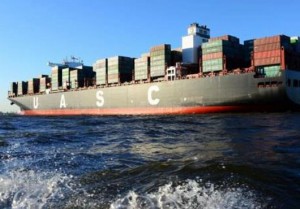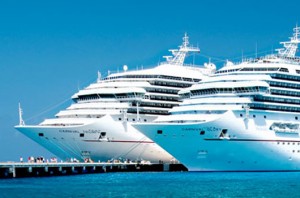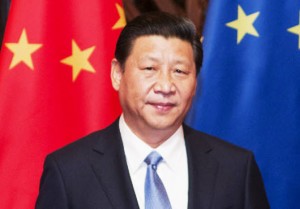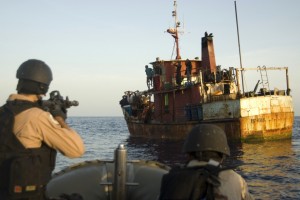Ahead of Petroleum Day, which will be marked on November 17th, we have prepared this interesting infographic for you. The infographic presents you with a lot of key information about shipping of oil, decline in oil spillages along with facts and figures about the international shipping trends.
Infographic: International Shipping ahead of Petroleum Day
Month: November 2014
European Maritime Industry Preps for 2050

The European maritime industry launched the European Research Association “Vessels for the Future” with its first general assembly held on November 5, 2014.
Looking towards 2050, Europeans will be using their maritime and inland waterways space for transport; offshore food production, energy generation, mineral exploitation as well as for urban dwelling; tourism; manufacturing; and trade. This calls for ambitious emission reductions and meeting stricter safety requirements with the advent of new technologies and operation scenarios. This also requires training of highly specialized manufacturing and operating personnel to use new vessels and systems and provide services in this future waterborne environment.
The European Commission’s Transport White Paper has as its central aim the need to deliver a competitive and resource efficient transport system for Europe. The new European Research Association “Vessels for the Future” will address the European policies of Transport, Enterprise, Energy, Environment and Climate Protection within the framework of Horizon 2020, building on the expertise of the WATERBORNE European Technology Platform and the wider maritime community.
In the European waterborne industry strategy – LeaderSHIP 2020 – the European Commission, Member States, Regions and the maritime technology industry concluded that to improve the global position and competiveness of the waterborne sector it is necessary to launch a major integrated initiative aiming at breakthrough technologies. In response, “Vessels for the Future” will target the societal challenge of moving towards sustainable transport whilst at the same time maintaining the cutting edge design, manufacturing and innovative production capacities. This will have a positive impact on employment and the global competitiveness of the European economy.
To implement the above, “Vessels for the Future” has set itself the goal to enter into a contractual Public Private Partnership with the European Commission.
UASC Eyes Reefer Expansion

Container shipping line United Arab Shipping Company (UASC) revealed plans to make significant investment in new reefer units at WOP Dubai, the international perishables expo for the Middle East.
UASC said that the expansion of its fleet of refrigerated units and enhanced geographic access to the South America trades – following UASC’s recently announced cooperation with Hamburg Süd – will ensure all UASC customers access to the South America trades as part of UASC’s comprehensive global reach, including those moving refrigerated cargo.
UASC’s expanding reefer fleet is one of the youngest in the industry, with an average reefer container age of three years. Some, 80% of UASC’s current reefer fleet has the ability to measure the CO2 levels of the cargo and automatically ventilate as required.
The announcement follows news of UASC’s current newbuilding program, comprising 17 ships (eleven 14,500 TEU vessels and six 18,800 TEU vessels), and cooperation with leading liner shipping companies CMA CGM and China Shipping Container Lines (together forming the Ocean Three alliance).
Maersk Satisfied with Results
Danish shipping giant Maersk Line delivered a profit of USD 685m, improving by USD 131m compared to Q3 2013, according to the third quarter results of the Maersk Group.
Maersk said that the improvement was driven by lower unit costs through the continuous focus on operational cost savings mainly from vessel network efficiencies supported by an increase in the average freight rate.
Return on invested capital (ROIC) improved from 10.9% in Q3 2013 to 13.5% in Q3 2014. The underlying result excluding one-offs came at USD 660m (USD 539m).
Revenue of USD 7.1bn was 4.3% higher than Q3 2013, positively impacted by a volume increase of 3.7% to 2,401k FFE as well as by the average freight rate increasing 0.9% to 2,679 USD/FFE.
Recognised freight revenue was USD 6.5bn (USD 6.1bn) and other revenue USD 599m (USD 662m). According to the report, unit cost decreased by 0.9% to 2,597 USD/FFE mainly driven by vessel network efficiencies and decreased bunker consumption.
Maersk Line’s nominal fleet capacity increased by 6.3% and the average vessel size increased by 5.6% compared to Q3 2013. Idle capacity at the end of Q3 2014 was 1k TEU (one vessel) versus 24k TEU (seven vessels) at the end of Q3 2013. Maersk Line’s idle capacity corresponds to less than 1% of total idle capacity in the market
Eight Triple-E vessels totalling 144k TEU are on order for delivery during 2014-2015. One Triple-E container vessel suited for the Asia-Europe trade will be delivered during Q4 2014.
The global market showed moderate growth of above 3% in Q3 2014 compared to Q3 2013, slightly lower than demand growth during the first half of 2014.
Maersk added that the global demand is currently being led by advanced economies while imports to emerging countries are slowing down. At the end of Q3 2014, the global container vessel fleet were at 18m TEU, an increase of 5.4% compared to a year ago.
While 367k TEU (53 vessels) were delivered during Q3 2014, only 44k TEU (30 vessels) were sent for demolition and idling was as low as 1.2% at the end of the quarter.
New ordering amounted to around 300k TEU (36 vessels), keeping the order book close to 20% of the fleet.
The underlying profit for the Maersk Group was USD 1.3bn when excluding discontinued operations, impairments and divestments, Maersk said in its interim report.
CLIA Sets Up Two Regional Arms in Asia

Cruise Lines International Association (CLIA), the world’s largest cruise industry trade association, has set up two regional arms in Asia, CLIA Southeast Asia and CLIA North Asia, so as to meet the needs of the growing cruise industry in the region.
CLIA Chief Executive Officer, Christine Duffy, said the transition to CLIA Southeast Asia and CLIA North Asia was perfectly timed as Asia comes to the forefront as one of the world’s most dynamic emerging regions for cruise.
“Asia ranks highly on our list of emerging cruise regions as the globalization of the cruise industry continues to gather pace,” said Duffy. “CLIA Member cruise lines are already deploying more ships in Asia, opening up more destinations, and customizing their onboard offerings to cater to their Asian guests.”
According to Duffy, CLIA Southeast Asia and CLIA North Asia will have an influential voice as they work with government and private enterprise to address market needs, master trade distribution, create highly desirable itineraries and offer advice on port and infrastructure.
CLIA Southeast Asia will be chaired by Carnival Australia CEO, Ann Sherry. Royal Caribbean’s Managing Director Singapore and Southeast Asia, Jennifer Yap, will be Secretary for the new cruise industry body.
Carnival Asia executives, Paul Chong and William Harber, have joined the CLIA Southeast Asia Board.
CLIA North Asia will be chaired by Royal Caribbean’s Managing Director Asia and China, Dr. Zinan Liu, and will focus on infrastructure, advocacy and the promotion of cruise to travel industry communities in the region.
Piracy in Sub-Saharan Africa Needs to Addressed on Land
Given the tremendous social and political conflict occurring in many piracy prone countries in Sub-Saharan Africa, counter-piracy efforts at sea will likely fail, as indicated in a recent research paper of the Office of Naval Research in the United States on the trends in maritime piracy.
Extant research shows state fragility, economic deprivation, population, and geographic opportunity are all related to the incidence of piracy in territorial waters. Similar to the growth of armed insurgencies, political and economic conditions help facilitate corruption and criminality, both of which enable piracy, Brandon C. Prins, Professor of Political Science at the University of Tennessee, notes in the research.
The average fragility score for the nine Sub-Saharan countries examined in the report (averaged across the 2009-2013 time period) is 16.8, which is 2.5 times higher than countries without piracy.
The average fragility score for countries without piracy during the 2009-2013 time period is 6.6. Somalia, with an average score of 24, represents the closest thing to a failed state in the international system. The political improvement Somalia witnessed from 2011 to 2012 (and likely into 2013 although the data for 2013 are not yet available) appears to have helped counter-piracy efforts in the Greater Gulf of Aden.
Given that trade in the greater Gulf of Aden is valued at nearly one trillion US dollars a year, it is clear why would-be pirates gravitate toward these waters. Further, Somalia despite having only five deep-sea ports, sits only five kilometers from where the Red Sea empties into the Gulf of Aden, and approximately twenty thousand ships transit through the Greater Gulf of Aden each year. These vessels represent in many cases easy targets for would-be pirates.
Economic deprivation within countries also helps to facilitate piracy and illegal markets more generally. Unemployed youth (especially males) provide the foot soldiers both for insurgencies and pirate gangs.
Some of the most piracy-prone countries remain some of the poorest places on Earth. Somalia had an average per capita GDP in 2009-2013 of only $562. Nigeria was slightly higher at $1,013.
Convincing individual fishers or farmers to forego the opportunity of a lucrative payoff (typically several thousand US dollars) remains difficult when there are few employment alternatives. And, monies from pirate operations tend to depress job growth in the legal economy.
The research shows that efforts to increase wages and job growth in piracy-prone countries must be part of an effective counter-piracy strategy.
Although pirate attacks dropped dramatically off the coast of Somalia in 2013, they increased significantly in the Gulf of Guinea. Counter-piracy naval operations and improved security onboard ships likely contributed to the decline in the greater Gulf of Aden.
Some strengthening in Somali governing institutions also likely had an effect even as armed conflict continued to create difficulties for the new regime. In the Gulf of Guinea, a deteriorating security environment and continued fragility in many West African governments provided space for pirate groups to operate.
China Earmarks USD 40 Bn for Silk Road Fund

China plans to invest USD 40 billion to establish a Silk Road Fund, as announced by the country’s president Xi Jinping at the Asia-Pacific Economic Cooperation conference last week, Xinhua news agency reported.
The meeting was attended by representatives from Bangladesh, Cambodia, Laos, Mongolia, Myanmar, Pakistan and Tajikistan along with the United Nations Economic and Social Commission for Asia and the Pacific and the Shanghai Cooperation Organization.
The fund is intended to revive maritime and land trade links between Asian countries by financing construction of infrastructural solutions and industrial and financial cooperation to reduce bottlenecks, Xunhua said.
The fund, controlled by the Chinese government, would be open to investors from both Asia and abroad.
The Chinese president introduced the “Belt and Road” initiatives to build a Silk Road Economic Belt and a 21st Century Maritime Silk Road in 2013, in an attempt to revive the historic trade routes between China and other Asian nations.
China is already investing strenuous efforts to bring stability to its sluggish shipbuilding and shipping industry, predominantly state-owned, by encouraging mergers and foreign investment.
Within the framework of boosting its shipping industry China has also established two banks: the New Development Bank and the Asian Infrastructure Investment Bank.
Quantum of the Seas Finally Home

Royal Caribbean International’s newest cruise ship, Quantum of the Seas, arrived into her homeport of Cape Liberty Cruise Port in Bayonne, New York on Monday, November 10.
The cruise ship, also referred to by its owner as the world’s first smartship, features a myriad of first-at-sea features and amenities, including the world’s first robotic bartenders, a skydiving simulator, bumper cars and futuristic entertainment.
The 16-deck, 213-foot high vessel is scheduled to set sail on her official maiden voyage on November 23 from Cape Liberty, New Jersey to the Bahamas.



